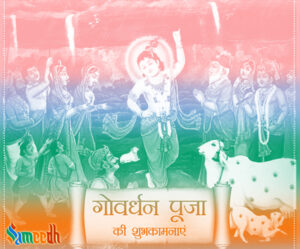Govardhan Pooja, also known as Annakut Pooja, is a Hindu festival celebrated in India and Nepal. It is observed on the fourth day of the festival of Diwali, which falls on the Hindu lunar month of Kartik.

Govardhan Pooja, also known as Annakut Pooja, is a Hindu festival celebrated in India and Nepal. It is observed on the fourth day of the festival of Diwali, which falls on the Hindu lunar month of Kartik. On this day, Hindus offer prayers to Lord Krushna and celebrate his victory over the king of gods, Indra.
As part of the celebration, devotees prepare a large mountain-like structure made of cow dung, called a Govardhan Parvat, and place various food offerings on top of it. The food offerings, known as annakut, are then distributed to the community as prasad.
In addition to the Govardhan Pooja, devotees also observe a fast on this day and participate in puja rituals, singing devotional songs, and reading stories about Lord Krushna’s life. The festival is an opportunity for devotees to express their devotion to Lord Krushna and thank him for his blessings.
Story
The festival commemorates the story of Lord Krushna lifting the Govardhan mountain to protect the people of the town of Vrindavan from the wrath of the king Indra.
According to Hindu mythology, Indira, the king of the gods, was jealous of Lord Krushna’s popularity and sought to destroy him. He summoned a great storm and deluge, hoping to drown the people of Vrindavan. However, Lord Krushna lifted the Govardhan mountain on his little finger and held it aloft for seven days and nights, protecting the people from the storm. When the storm subsided, the people of Vrindavan were saved and Indira was defeated.
In honor of Lord Krushna’s victory and his protection of the people, Hindus observe Govardhan Pooja on the fourth day of Diwali. Devotees prepare a large mountain-like structure made of cow dung, called a Govardhan Parvat, and place various food offerings on top of it. The food offerings, known as annakut, are then distributed to the community as prasad.
Spiritual Meaning
The spiritual significance of Govardhan Pooja lies in the message of Lord Krushna’s actions. By lifting the Govardhan mountain and protecting the people of Vrindavan, Lord Krushna demonstrated his divine power and his role as protector and savior of his devotees. He also symbolized the importance of devotion and surrender to God, as the people of Vrindavan entrusted their safety to Lord Krushna and were saved by his grace.
Observing Govardhan Pooja is a way for devotees to express their devotion to Lord Krushna and thank him for his blessings. It is also an opportunity for devotees to reaffirm their faith in God and surrender to his will.
Location
Govardhan Parvat, also known as Mount Govardhan, is a small hill located in the town of Vrindavan in the Mathura district of Uttar Pradesh, India. It is considered a sacred site in Hinduism. The hill is revered as a symbol of Lord Krushna’s divine power and his role as protector and savior of his devotees. It is a popular place of pilgrimage for Hindus and is visited by thousands of devotees every year. Govardhan Parvat is also known for its many temples and holy sites, including the Govardhan Temple, the Radha Damodar Temple, and the Mukharbind Temple. These temples are visited by devotees who come to offer prayers and seek blessings from Lord Krishna. The hill is located about 70 km west of the city of Agra, and can be reached by road from Mathura or Agra.